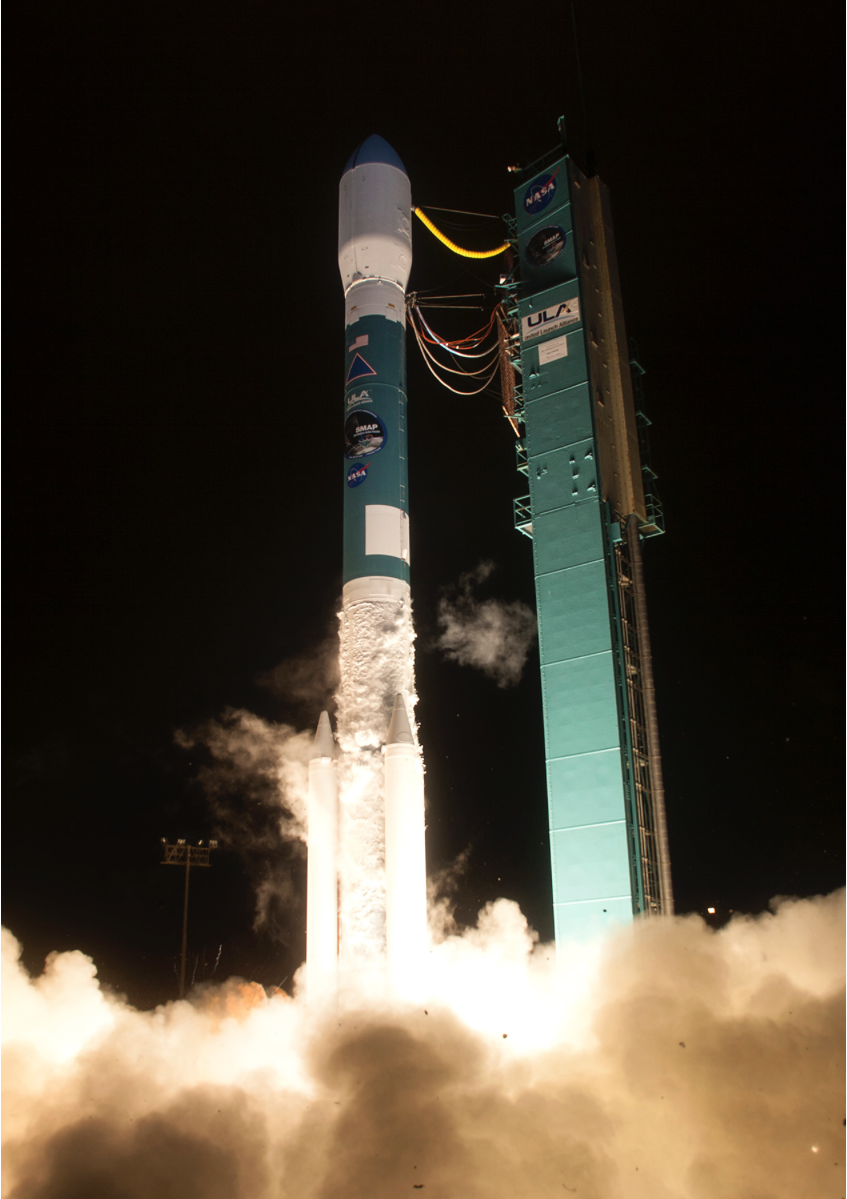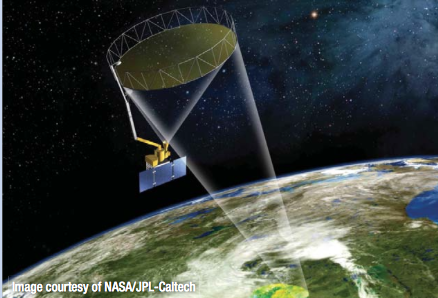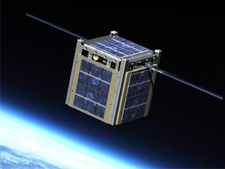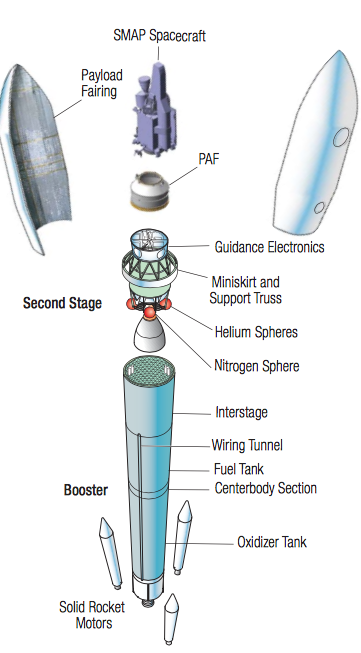
Vandenberg Air Force Base, California (January 31, 2015) – A United Launch Alliance (ULA) Delta II rocket carrying the Soil Moisture Active Passive (SMAP) payload for NASA lifted off from Space Launch Complex-2 at 6:22 a.m. PST today. The SMAP mission is NASA’s first Earth-observing satellite mission designed to collect global observations of surface soil moisture and its freeze/thaw state, data that have broad applications for science and society. Photo: United Launch Alliance
[SatNews] Statement from ULA:
A United Launch Alliance (ULA) Delta II rocket carrying the Soil Moisture Active Passive (SMAP) payload for NASA lifted off from Space Launch Complex-2 at 6:22 a.m. PST today. This launch marks ULA’s second launch of 13 planned for 2015, and the 93rd successful mission since the company was formed.
The SMAP mission was launched aboard a Delta II 7320 configuration vehicle featuring a ULA first stage booster powered by an Aerojet Rocketdyne RS-27A main engine and three Alliant Techsystems (ATK) strap-on solid rocket motors. An Aerojet Rockedyne AJ10-118K engine powered the second stage. The payload was encased by a 10-foot-diameter composite payload fairing.
In addition, the Delta II delivered four educational cubesats as part of NASA’s Educational Launch of Nanosatellite (ELaNa) initiative.
The SMAP mission is NASA’s first Earth-observing satellite mission designed to collect global observations of surface soil moisture and its freeze/thaw state, data that have broad applications for science and society.
ULA's next launch is the Atlas V Magnetospheric Multiscale (MMS) mission for NASA, scheduled for March 12 from Space Launch Complex-41 from Cape Canaveral Air Force Station, Florida.
With more than a century of combined heritage, United Launch Alliance is the nation’s most experienced and reliable launch service provider. ULA has successfully delivered more than 90 satellites to orbit that provide critical capabilities for troops in the field, aid meteorologists in tracking severe weather, enable personal device-based GPS navigation and unlock the mysteries of our solar system. End ULA Statement
Moog Statement:
Moog Inc. (NYSE: MOG.A and MOG.B) Space and Defense Group provided propulsion control to the NASA Jet Propulsion Laboratory’s (JPL) Soil Moisture Active Passive (SMAP) spacecraft that launched today from Vandenberg Air Force Base in California, carried aloft by a United Launch Alliance Delta II rocket. SMAP will use a combined radiometer and high-resolution radar to measure surface soil moisture and freeze-thaw state, providing for scientific advances and societal benefits with a further understanding of weather and climate.
The United Launch Alliance Delta II launch vehicle is equipped with an engine swing check valve and servovalves on its first stage to aid in engine control upon liftoff. Moog also supplies the second stage engine control pilot valve for the AJ-10 upper stage engine, which controls hydrazine to the main valve. The second stage of the Delta II guided the SMAP satellite into its injection orbit where it will perform propulsive maneuvers to reach its final, sun-synchronous orbit 426 miles (685 km) from Earth.
Moog delivered nine MONARC-5 thrusters and one qualification thruster to JPL. Thrusters were integrated onto SMAP and activated soon after separation from the Delta II second stage to de-tumble the spacecraft and initiate sun acquisition after solar array deployment. The MONARC-5 has a long heritage, dating back more than 30 years, with flight heritage on a range of commercial and exploration missions including Worldview, LCROSS and MMS. Nearly 600 MONARC-5 hydrazine monopropellant thrusters have been delivered and flown.

Moog fill and drain valves also contribute to the SMAP propulsion system. High reliability of the propulsion system is crucial to ensure correct positioning of the spacecraft.
SMAP will provide direct measurements of soil moisture and freeze/thaw state, which are needed to improve our understanding of regional water cycles, ecosystem productivity, and processes that link the water, energy, and carbon cycles. SMAP science measurements will be acquired for a period of three years. A comprehensive validation program will be used to assess the accuracies of the soil moisture and freeze/thaw estimates. End Moog Statement
NASA and the Launch Services Program are partnering with several universities to launch small research satellites. These small satellites are called CubeSats because of their shape.
Small satellite missions provide NASA with valuable opportunities to test emerging technologies and economical commercial off-the-shelf components that may be useful in future space missions.

This image is an artists rendition of Montana State University's Explorer-1 [Prime] CubeSat. Source: Montana State University, Space Science and Engineering Laborator
NASA nanosatellites are designed for a wide spectrum of space missions, including biology experiments, testing advanced propulsion and communications technologies.
CubeSats are in a class of small research spacecraft called picosatellites. They have a size of approximately 4 inches, a volume of about 1 quart and weigh no more than 2.2 pounds.
NASA's Kennedy Space Center in Florida is adapting the Poly-Picosatellite Orbital Deployer, or PPOD, to put these CubeSats into orbit. This deployment system, designed and manufactured by the California Polytechnic State University in partnership with Stanford University, has flown previously on Department of Defense and commercial launch vehicles.
Payload Fairing (PLF)
The PLF is a composite bisector (two-piece shell), 10-ft diameter fairing. The PLF encapsulates the spacecraft to protect it from the launch environment on ascent. The vehicle’s height, with the 10-ft PLF is approximately 128 ft.

Second Stage
The Delta II second stage propellant tanks are constructed of corrosion-resistant stainless steel. The Delta II second stage is a hypergolic- (Aerozine 50 and Nitrogen Tetroxide) fueled vehicle. It uses a single AJ10-118K engine producing 9,850 lb of thrust. The propellant tanks are insulated with Dacron/Mylar blankets. The second stage’s miniskirt/guidance section provides the load path for the payload to the booster as well as, the structural support for the second stage propellant tanks, the PLF, mountings for vehicle electronics, and the structural and electronic interfaces with the spacecraft. The second stage, other than the mini-skirt, is nested inside the interstage adapter.
MISSION OVERVIEW
Booster
With more than a century of combined heritage, United Launch Alliance has successfully delivered more than 90 satellites to orbit that provide critical capabilities for troops in the field, aid meteorologists in tracking severe weather, enable personal device-based GPS navigation and unlock the mysteries of our solar system.
- 43rd Delta II Launch from Space Launch Complex-2 - 52nd NASA Mission on Delta II
- 153rd Delta II Launch
The Delta II booster is 8 ft in diameter and approximately 87 ft in length. The booster’s fuel and oxidizer tanks are structurally rigid and constructed of stiffened isogrid aluminum barrels and spun-formed aluminum domes. The booster structure is completed by the centerbody, which joins the fuel and oxidizer tanks and the LO2 skirt, which joins the tank structure to the engine section. Delta II booster propulsion is provided by the RS-27A engine. The RS-27A burns RP-1 (Rocket Propellant-1 or highly purified kerosene) and liquid oxygen, and delivers 200,000 lb thrust at sea level. The Delta II booster is controlled by the second stage avionics system which provides guidance, flight control, and vehicle sequencing functions during the booster and second stage phases of flight.

